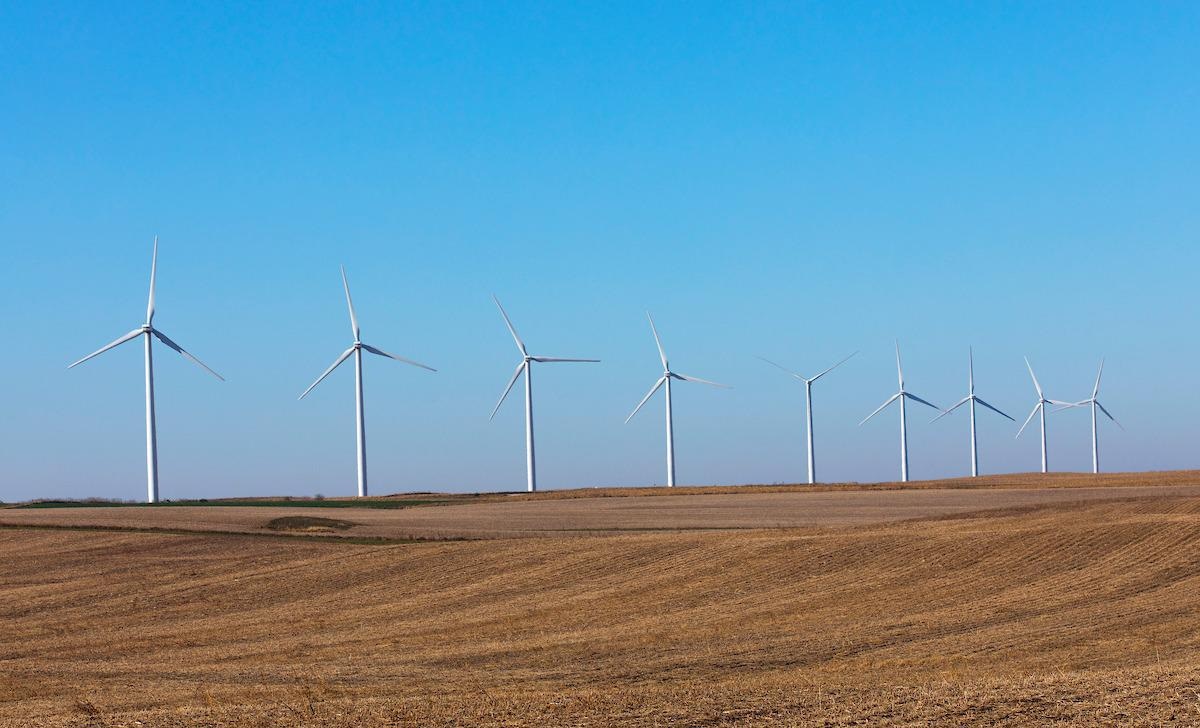When the power grid goes down, there is a recovery process – a so-called “blackstart”– that until now has relied on power from gas or hydro turbines spinning away within a power plant.
 Wind turbines spin over farm fields north of Ames. Iowa State’s Hugo Villegas Pico is leading development of a control strategy that restores wind-dominant electric grids from blackouts. Image Credit. Christopher Gannon.
Wind turbines spin over farm fields north of Ames. Iowa State’s Hugo Villegas Pico is leading development of a control strategy that restores wind-dominant electric grids from blackouts. Image Credit. Christopher Gannon.
It was all comparatively simple to control. Startup the turbines, utilize them to spin generators and watch the electrons flow in a steady and predictable manner to reenergize a grid and resist short circuits and other faults.
However, when it comes to a wind power plant, one that extends throughout the countryside, is not so steady and forecastable, and relies on wind blowing, what occurs when a wind-dominant grid goes black and how engineers get a wind farm with hundreds of separate power generators working jointly to get electricity back to homes and businesses is unknown.
That is one of three significant “Grand challenges in the science of wind energy,” as per an October 2019 headline and paper in the journal Science. (Paul Veers of the National Renewable Energy Laboratory in Colorado is the lead author.)
Hugo Villegas Pico, a Harpole-Pentair assistant professor of electrical and computer engineering at Iowa State University saw the study and thought he could fabricate solutions for grand challenge three.
Optimization and control of fleets of wind plants comprising hundreds of individual generators working synergistically within the larger electric grid system.
Hugo Villegas Pico, Harpole-Pentair Assistant Professor, Electrical and Computer Engineering, Iowa State University
In 2020, a three-year grant of $729,349 was given to Villegas and his research group by the US Department of Energy’s Office of Basic Energy Sciences, to identify how to orchestrate the restoration of wind-dominant electric grids following a blackout.
In a research paper published in IEEE Transactions on Energy Conversion, Villegas Pico and Vahan Gevorgian, a chief engineer at the National Renewable Energy Laboratory, explain the development of grid-forming controllers and a stall-prevention subsystem allowing wind turbines to blackstart a power grid.
This is a crucial step for building up the flexibility of wind farms to blackouts.
“If wind power plants are not able to restore a power system, the incorporation of wind resources into electric grids could be limited by blackstart capability,” the researchers wrote in their paper.
Iowa has around 11,660 megawatts of installed capacity (with 437 more under construction), and generates 55% of its electricity from the state’s winds. This makes wind power plants a reality throughout the state.
So, what would it take to use them to restart a grid after a blackout?
Villegas Pico states the first difficulty for “Type 4” turbines, which feature fully-rated electronics converters to convert all their producing capacity to the grid, was engineering a grid-forming control plan enabling turbines to function on the grid separately from any gas or hydro turbines. At present, this is not possible.
The control strategy is a software algorithm. It steers the operation of wind turbines so they’re capable of reliably restoring power systems.
Hugo Villegas Pico, Harpole-Pentair Assistant Professor, Electrical and Computer Engineering, Iowa State University
Specifically, the software enables the turbines to work together and withstand asymmetrical grid faults, including those caused by trees that take down and short-circuit part of the transmission and distribution grid.
The second difficulty was developing an active protection system that would prevent wind turbines from stalling — stopping — if power demand is greater compared to the available wind at the time of the recovery from a blackout.
The researchers demonstrated that their novel control systems can reenergize a wind-dominated power grid, ride through asymmetrical flaws, and withstand low-speed winds by plugging their ideas into a computer model.
Villegas Pico believes that the use of wind power to restore power grids could speed up the process in places like Iowa, where there are an increasing number of wind farms. These days, there are a lot of turbines to work with.
The research group is also implementing these breakthroughs in other types of wind turbines and power systems that use batteries to store energy, according to Villegas Pico. Artificial intelligence and weather forecasting tools are also being developed as part of the project to assist operators in orchestrating the restoration of wind-dominant grids.
According to Villegas Pico, the new advancements could be used in wind power plants in a matter of years, benefiting utilities and their customers.
Our contributions are significant to satisfy restoration, reliability, and interoperability standards. They are also important to note: jeopardize restoration processes, cause economical losses, and endanger lives, for example, if electricity is critical for heating in cold weather.
Hugo Villegas Pico, Harpole-Pentair Assistant Professor, Electrical and Computer Engineering, Iowa State University
Journal Reference:
Pico, H. N. V., et al. (2022) Blackstart Capability and Survivability of Wind Turbines with Fully Rated Converters. IEEE Transactions on Energy Conversion. doi.org/10.1109/TEC.2022.3173903.